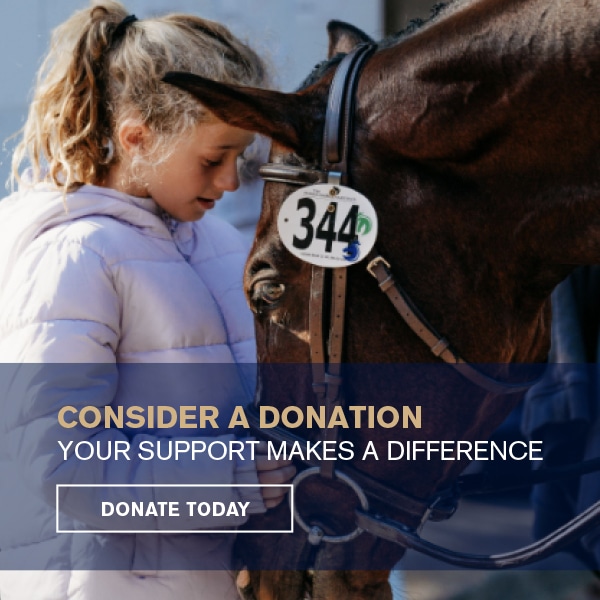Options for horses coming off the track that aren’t sound enough for athletic second careers
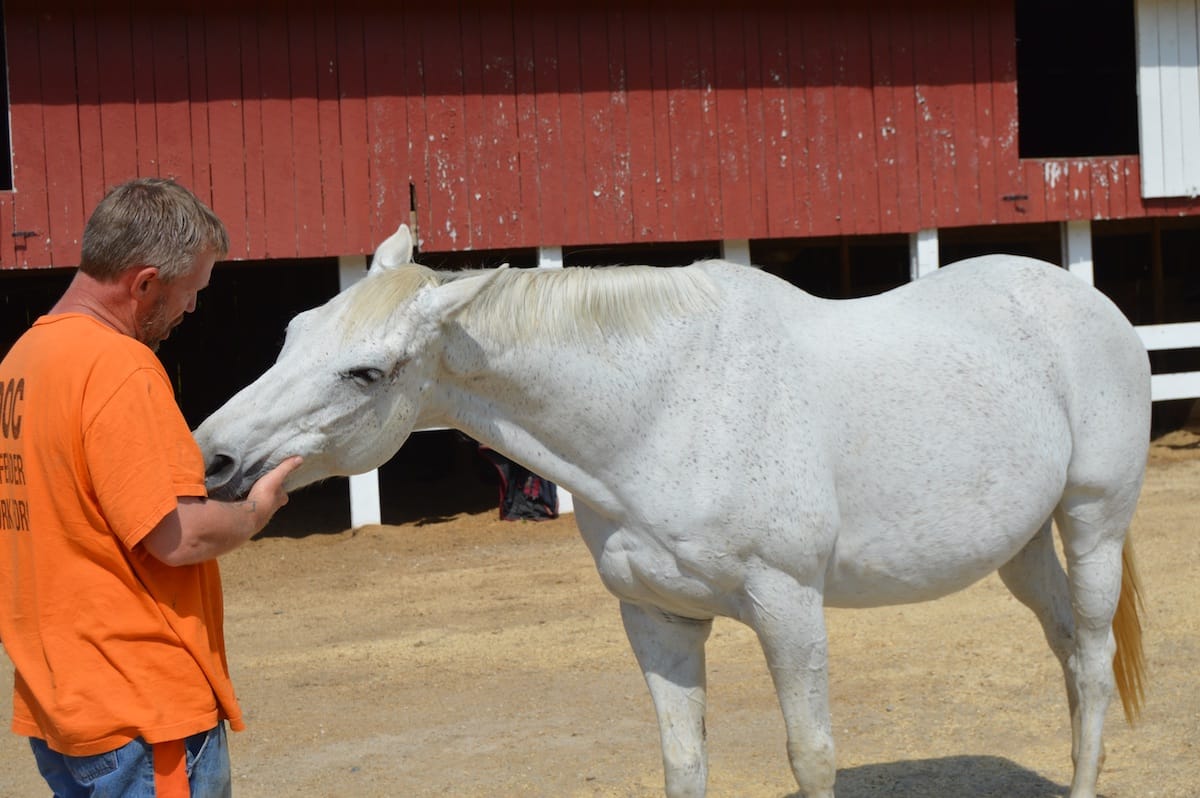
Nineteen-year-old Jonathons Gal helps teach inmates life and vocational skills as part of the Thoroughbred Retirement Foundation’s Second Chances program. Courtesy Jennifer Stevens
Most of the off-track Thoroughbreds that grace Off-Track Thoroughbred Magazine‘s pages are a testament to the horses’ successful transitions from racing to equestrian sport. After all, the Retired Racehorse Project’s mission is to facilitate that transition and increase demand for these animals.
But what about the ones whose time on the track has left them with lasting scars? We’re talking about the old arthritic campaigners; the no-names; the horses that will never be sound enough to clear jumps or turn barrels. What options do they have after their racing careers are over?
A Population Most At Risk
While interest in athletic young Thoroughbreds retiring from the track has exploded in recent years, there’s simply not much market for OTTBs as pasture buddies or trail horses. Of the 750 ex-racers in the Thoroughbred Retirement Foundation’s (TRF) care, last year only a dozen found homes as companion or light riding horses, says director of development and communications Jennifer Stevens, who is based in Saratoga Springs, New York. Meanwhile, she says, she fields multiple phone calls a day from people trying to find homes for their well-worn retired racehorses.
“Most people don’t want to feed a horse they’re not doing anything with,” says Nicole Smith, executive director of the Exceller Fund, an organization headquartered in Lexington, Kentucky, that provides sanctuary for and facilitates placement of at-risk OTTBs, particularly those racing warriors with upward of 100 starts. “Those are the horses that often end up in bad situations down the road. It’s not to say homes aren’t out there, but the fact of the matter is there aren’t that many.”
Consequently, she says, unsound ex-racehorses are particularly at risk of ending up neglected, abused or on a truck to Mexico or Canada, where slaughter plants await.
This is where farms and organizations such as Old Friends, TRF, Exceller Fund and a whole host of Thoroughbred Aftercare Alliance (TAA)-accredited programs come into play. This network of sanctuaries, rehab farms and adoption agencies is helping not only save horses’ lives but also give them new jobs in retirement.
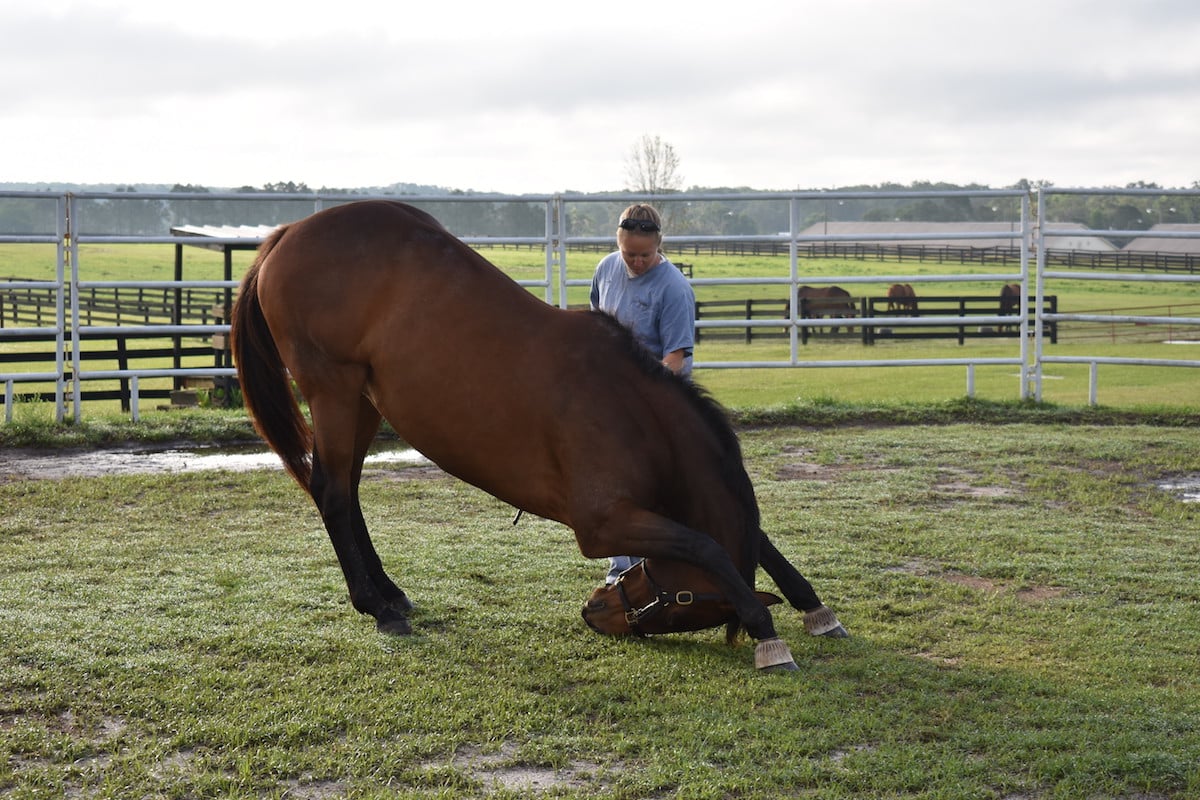
Horses in TRF’s Second Chances program perform nonridden work, including tricks. Courtesy Chelsea O’Reilly
Giving Them Purpose
Just because a horse won’t make it as a riding mount doesn’t mean he can’t have a purpose in life. After giving new arrivals time to let down and learn to be horses again, organizations such as TRF and Exceller Fund evaluate each one to determine its best path. While some horses will truly be retired for the rest of their lives, others find work in therapy or vocational programs.
Thoroughbred Retirement Foundation horses, for instance, are spread among 21 foster, private and Second Chances farms. Second Chances is a program TRF has instituted at correctional facilities in nine states to teach inmates life and vocational skills. The curriculum is designed to prepare its students to work on horse farms after being released from prison, but the communication, compassion and leadership skills they learn from working with horses can transfer to any industry, says Stevens.
“The job of the horse (in this program) is nonriding, which suits most of our horses because they are unsuitable for a secondary athletic career,” says TRF development associate Chelsea O’Reilly.
The horses do groundwork and round pen work and learn to long-line. Some even learn to drive. At the program’s one facility for women, in Florida, a trainer works with the inmates to teach the horses to do tricks such as bow and nod their heads. In turn, the women hone their patience, listening and communication skills.
Some of the Second Chances farms also offer Groom Elite Program classes. So while the horses are teaching the inmates poise and horsemanship, those individuals are providing the horses with hands-on daily care and rehab.
“If (a TRF horse) needs a lot more care and supervision because of an injury, they will be at one of the prison farms because the inmates are so hands-on,” says Stevens.
“The horse with a giant bowed banana tendon is getting loved on every day,” O’Reilly adds.
The Exceller Fund has recently established a similar program for its retirees, called Operation Therapeutic Warrior, through which it retrains OTTBs as nonriding therapy horses for veteran and at-risk youth programs.
A trainer first evaluates horses using a point system to determine if they’re physically comfortable and mentally composed enough for the job.
“There’s a little bit of physicality,” says Smith. “They need to be able to walk, trot and do round pen work.”
She adds that the Thoroughbreds’ perceptive nature makes them particularly well-suited for these programs. “The reason they work so well is because they are sensitive and reactive to things,” she says. “They’re also used to being pampered princes and princesses (on the track), and they like that attention. This is perfect for them.”
Other Exceller Fund horses have seasonal jobs as babysitters, such as on Thoroughbred breeding farms in need of mature companions to keep yearlings in check. And some just need time to heal and unwind.
“If they’re just not sound enough or mentally not ready, they’ll go to a retirement farm for a year or two or five,” says Smith. “They’ll go be a horse for a while and all of a sudden come out of their shell and be ready to go. They needed that time.
“Some will never be ready,” she adds. “If they need to just be turned out and be a horse for the rest of their life, that’s fine. If they show potential for therapy programs, they will go do that. If they’re adoption candidates, they’ll go do that.”
Stevens says they do encounter adopters looking for pasture-sound OTTBs with good temperaments. “It’s great because those horses get babied and go to great homes,” she says, but admits this scenario isn’t very common.
“The majority of people looking for OTTBs want to compete,” says O’Reilly. “There are some that want trail riding horses, but those are harder to come by.”
Inevitably, many retired racehorses will only ever be pasture horses. That’s where sanctuary and retirement farms are so important for giving these animals forever homes.
“We owe them that retirement,” says Smith.
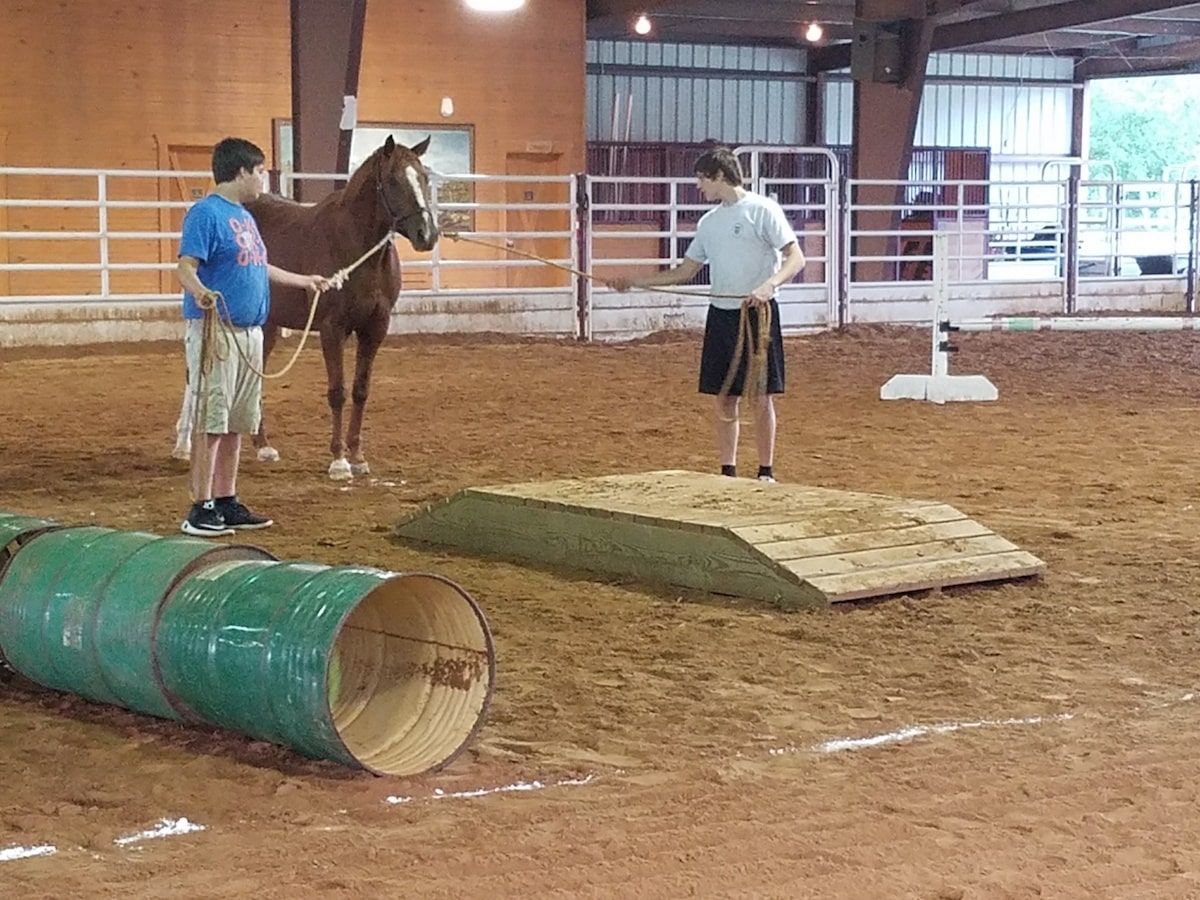
The Exceller Fund retrains suitable OTTBs as nonriding therapy horses for at-risk youth programs such as this one at the Tulsa Boys Home. Courtesy The Exceller Fund
A Job Will Do Them Good
Just like humans, most horses benefit from having a purpose in life. “I think any horse that continues to be useful and contribute to things on a daily basis has a much greater sense of well-being than one that does not have a job,” says Karyn Malinowski, PhD, director of the Rutgers Equine Science Center, in New Jersey. She has studied equine physiology and aging in horses extensively.
She fondly recalls Lord Nelson, a former mounted patrol horse at Rutgers who, after retiring at age 25, made it clear he still wanted a job. He came out of retirement to serve as an advocate for environmental stewardship on farms and continued galloping around his field until his death at the ripe old age of 42.
“I think there’s absolutely a place for retired racehorses who aren’t 100 percent sound to still have an active life and contribution to society,” Malinowski says.
For instance, OTTBs with quiet dispositions can make for excellent participants in equine assisted therapy programs and camps, whether simply doing activities on the ground or teaching a rider to walk and trot.
“That may not seem like a big job, but that horse still has a purpose in its life,” she says. “I think you can see from their outward signs that they enjoy interacting with people, being brushed and exposed to people — when whistled to they come to the gate.”
And the physical stimulation is just as important as the mental. Malinowski performed an exercise study on a group of 25- to 35-year-old Standardbred ex-racehorses. Each one spent 30 minutes on an Equi-Ciser three days a week; within three or four weeks, the research team noted obvious improvements in the horses’ fitness and comfort.
“In the morning they were waiting by the paddock gates for their turn to get on the machine,” she says. “When they finished and were turned back out, they were heels up in the air, playing and running around. As former racehorses, you know they had aches and pains and arthritis going on in those old joints, but they were still bucking and running around those paddocks because they felt so good.”
While Malinowski is a proponent of letting a horse be a horse and do anything it’s physically capable of doing, she emphasizes the importance of knowing when you’re pushing one to its limits: “If it shows signs of being uncomfortable or needs to be medicated with non-steroidal anti-inflammatories on a regular basis, it’s time to back off.”
Changing Trends
On the other side of the track are the industry players who are retiring their horses sooner and also trying to find good outlets for the ones that do suffer career-ending injuries.
“A lot of the owners and trainers that didn’t use to reach out (to find placement for horses) are starting to reach out now, which is really encouraging,” says Smith. “It used to be ‘just get them gone as fast as you can.’ ”
Part of that change comes from education. “Some states are starting to require educational programs for trainers — to be at the track, they have to attend them,” says O’Reilly. “A lot of owners I’ve noticed at these educational seminars are stepping up and saying, ‘I really want to be more involved. I want to know where my horse goes.’ ”
Industry players are also setting up more safety nets for these horses, such as New York Racing Association’s Take the Lead program to help owners and trainers find their runners retirement homes.
“The awareness that these programs are out there is encouraging people to reach out and say, ‘My horse isn’t going to be able to run anymore. Can you help me find something for him?’ It’s no longer taboo,” says Stevens.
The racing industry, through the likes of TAA and Thoroughbred Charities of America, has also upped its support of these horses in retirement — particularly the ones that aren’t sound enough to show up on CANTER (Communication Alliance to Network Thoroughbred Ex-Racehorses) listings and other rehoming forums.
“We feel like the racing industry is really stepping up,” says Smith. “They’ve been very supportive, and we’re very thankful for that.”
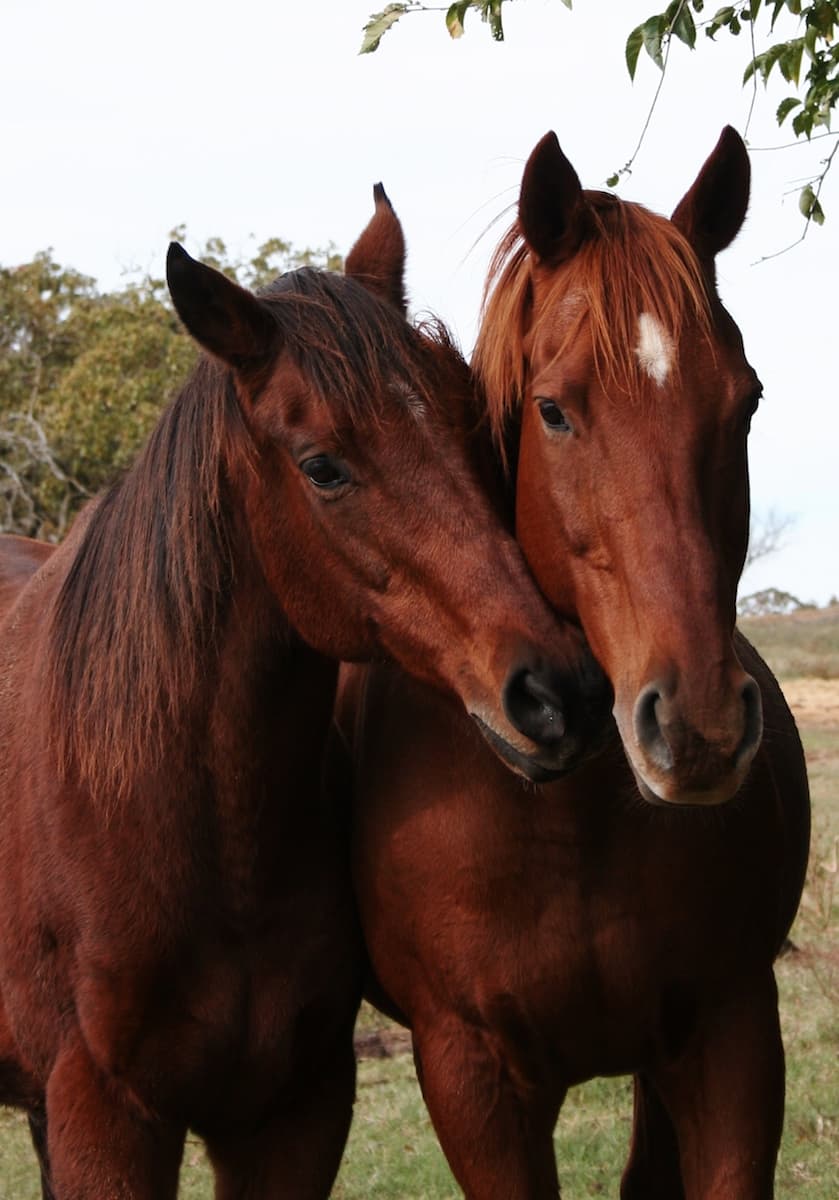
Cumberland Gap and Beaudazzler are two racing warriors the Exceller Fund has given a home to after racing. Courtesy The Exceller Fund
We Owe it to Them
With upward of 20,000 Thoroughbred foals born in North America each year, there’s going to be a percentage of them that can’t jump or run cross-country after their racing careers are over.
“Those horses still need to be cared for for the next 20 years,” says Stevens. And giving them a purpose, be it as a companion, a teacher or a healer, can help give them value and access to that care.
“It’s just getting the word out to the general public that these horses aren’t worthless and they don’t need to be cast aside or put down just because they can’t be ridden,” says Smith. “When people say they’re useless, that’s like a dagger to my heart.”
Euthanasia: Not a Dirty Word
For the horse so plagued by injury that his quality of life suffers or he’s at risk of ending up in the wrong hands, we might be doing the right thing by resorting to humane euthanasia.
“If you’re really doing best by the horse, that’s something that needs to be considered,” says Jennifer Stevens, the Thoroughbred Retirement Foundation’s (TRF) director of development and communications. “It comes down to a quality of life.”
The Exceller Fund, which can only house 50 horses at a time, has even set up a euthanasia fund in partnership with one of its veterinarians.
“If we can’t take the horse but the owner is going to send it into the world not knowing what’s going to happen to it, and odds are it’s going to end up in a bad place or the wrong hands, we’ll offer the euthanasia fund as an alternate option,” says executive director Nicole Smith.
“No one wants to do it, we don’t want to do it, but I’d rather see that than the horse end up starving in a field somewhere.”
Similarly, the TRF herd managers and veterinarians abide by American Association of Equine Practitioners euthanasia guidelines with their own horses. “We have some (horses) who are doing well, but at a certain point their injuries do catch up with them,” says Stevens. “If a horse is in pain or not thriving, that’s when the decision is made for their quality of life.”
This article was originally published in the Summer 2018 issue of Off-Track Thoroughbred Magazine, the only publication dedicated to the Thoroughbred ex-racehorse in second careers. Want four information-packed issues a year delivered to your door or your favorite digital device? Subscribe now!

